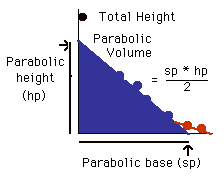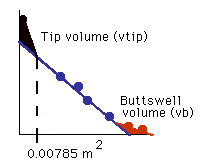
Method for estimating volume
Forest Measurement and Modelling.
 |
Gray's taper line Method for estimating volume Forest Measurement and Modelling. |
     |
|
|
| Subjectively select 5-7 representative points for measurement, two in the buttswell region and 3-5 along the main stem up to at least half height. Measure diameter over bark (DOB), bark thickness (BT) and height above ground at each point. Convert the diameter measurements to sectional areas under bark (SAUB) and plot against height above ground (rectangular coordinate paper). Plotting is done by a recorder on the ground as measurement proceeds. |  | |
| As soon as the recorder is confident of fitting a straight line to the points representing the paraboloid of the main stem, the measurer returns to ground. Measure total height above ground. |  | |
| Extend the taper line fitted to the points on the main stem to cut the SAUB axis (abscissa) at parabolic base (sp) and the height axis (ordinate) at parabolic height (hp). The area under this taper line represents parabolic volume (vp) and, being a triangle, vp = (sp x hp)/2. |  | |
| Fit a curve or straight line to the points in the buttswell region and determine the area between the curve, taper line and SAUB axis either by square counting or from the dimensions of the triangle formed by the straight line which approximates the buttswell curve. This gives buttswell volume (vb). Join the total height point on the ordinate to the 10 cm DUB point (= 0.007 85 m2) on the taper line. Experience has shown that the inflection point (paraboloid to conoid) on the upper main stem occurs at approximately the 10 cm DUB point. Tip volume (vtip) is then given by the area enclosed by the height axis, taper line and the line from the tip to the 10 cm DUB point, and is determined as for vb. Total volume = vp + vb + vtip. |  | |
| Merchantable height is normally less than parabolic height in conifers, so if volume to the merchantable limit is required, subtract the non-merchantable part of parabolic volume (represented by the appropriate triangle) from vp + vb. Subtracting stump volume from the result gives actual merchantable volume. | 
|
| Note: If parabolic height (hp) equals or exceeds total height, an error should be suspected either in measurement, conversion of DUB to sectional area, or in plotting. In the rare case of a stem which carries its paraboloidal shape to the tip, parabolic height may approximate total height. Unhealthy stems (particularly on poor sites) sometimes exhibit this feature.
The taper line method thus assumes that the main stem approximates a second degree paraboloid with a skirt of buttswell of varying size at the base and, in the case of conifers, surmounted by a cone like top (only if a curved line drawn from hp to the tip). This assumption results in a minimum number of measurements and a saving in time, energy and risk which may be considerable.
Other advantagesThe graph provides a visual check on measurements and recording and a permanent record of the stem.Volumes of assortments can be determined at any time to adjust for changing standards of utilisation.
DisadvantagesTwo disadvantages result because the points of measurement are few and subjectively chosen:
|

[gray.htm] Revision: 6/1999
Cris.Brack@anu.edu.au